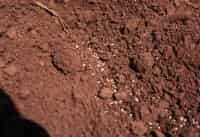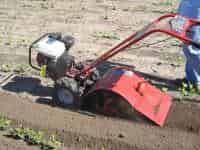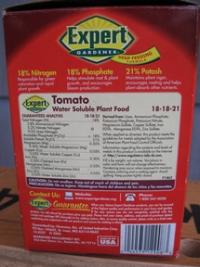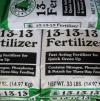Contact
For more information, contact your local county Extension Agent.
Prepare Your Garden | Soil Testing, Preparation, and Amendments
Soil is the foundation of a healthy garden, so it's important to check the pH and levels of nutrients before gardening. Soil testing can be done in the fall or in the spring before the lawn greens up. We offer Arkansas homeowners free soil testing.
Do I really need to soil test?
A soil test can make the difference between success and failure in the garden. 
Soil tests are desirable to determine the pH level and the amount of nitrogen, phosphorus, potassium and calcium in the garden’s soil. They are helpful if the samples are taken properly and the recommendations followed. Your county Extension office has instructions and containers for submitting the samples.
The pH of the soil can be adjusted to make sure that soil nutrients are available. Most native soils in Arkansas are acidic and need to be amended with lime to raise the soil pH.
What's the best pH for Vegetable Gardens?
The vegetable garden should be slightly acidic with a pH level ranging from 5.8 to 6.8. Lime takes 6 to 8 weeks to alter soil pH and should be applied in the fall or late winter. Agricultural lime has a mix of particle sizes and will provide long term control of soil pH. Pelletized or lawn lime has very fine particles and reacts over a much shorter period of time but needs to be reapplied annually. Reduce the recommended rate if using pelletized lime.
Liming the soil makes nutrients available to the plants, especially calcium. Gypsum can be added to increase calcium if the soil pH does not need to be raised by lime.
| FSA-2121 | Test Your Soil for Plant Food and Lime Needs |
| FSA-2118 | Understanding the Numbers on Your Soil Test Report |
| Collecting a Soil Sample with Julie Treat, Horticulture Program Technician, UACES |
What's the best way to prepare the soil?
Arkansas soils range from coarse sands to heavy clays. Each presents a special situation to the gardener. The type of soil is an important consideration if there is a choice.
- Sandy loam or loam soils are well adapted to vegetable production. Although sandy
soils are quite workable, they do not hold water or fertilizer nutrients as well as
clay soils. Adding large amounts of organic matter such as organic compost and manures
will greatly improve the nutrient and water holding ability of these soils.
- Vegetables may be grown on heavier soils if they are well-drained. Heavier soils
have clay particles which are smaller than sand and become quite hard. They are usually
productive if managed properly.
Amendments such as sand, finely ground bark, gypsum, vermiculite or perlite, composted
organic matter and organic mulching can be added to clay soil to improve soil conditions
and provide more air spaces for roots.
Tips for Soil Preparation
![]() Small garden plots can be prepared for planting by using a spade, shovel or spading
fork to turn the soil. Turn the soil to a depth of 6 to 7 inches. Use a small tractor
or garden tiller for larger gardens.
Small garden plots can be prepared for planting by using a spade, shovel or spading
fork to turn the soil. Turn the soil to a depth of 6 to 7 inches. Use a small tractor
or garden tiller for larger gardens.
![]() Do not spade, till, plow or cultivate soil when it is too wet. Pick up a handful
of soil and squeeze it. If the dirt sticks together and will not crumble after squeezing,
wait until it is drier.
Do not spade, till, plow or cultivate soil when it is too wet. Pick up a handful
of soil and squeeze it. If the dirt sticks together and will not crumble after squeezing,
wait until it is drier.

![]() All litter or trash on the soil surface should be completely covered or worked into
the soil when the ground is turned. Excessive trash in the upper soil level interferes
with final seedbed preparation and later cultivations. This is a good time to add
compost and soil amendments such as agricultural lime.
All litter or trash on the soil surface should be completely covered or worked into
the soil when the ground is turned. Excessive trash in the upper soil level interferes
with final seedbed preparation and later cultivations. This is a good time to add
compost and soil amendments such as agricultural lime.
![]() Establish a smooth, level surface by raking or harrowing as soon as possible after
turning. This helps compact the soil, breaks up clods and leaves a smooth surface
for seeding. Soil left in rough condition for several days after turning may dry
out and form hard clods, making it much more difficult to prepare a good seedbed.
Small seeds germinate poorly in loose soil with clods, and growth of the seedlings
may be slow and weak.
Establish a smooth, level surface by raking or harrowing as soon as possible after
turning. This helps compact the soil, breaks up clods and leaves a smooth surface
for seeding. Soil left in rough condition for several days after turning may dry
out and form hard clods, making it much more difficult to prepare a good seedbed.
Small seeds germinate poorly in loose soil with clods, and growth of the seedlings
may be slow and weak.
How do I use my soil report to make amendments?
Reading a soil report can be overwhelming, especially for new gardeners. Learn how to focus on what's most important to helping your garden grow by watching Episode 2 from the Gardening from the Ground Up Series.
Soil Amendments
There are different ways to amend your soil using compost, fertilizers, and/or cover crops.
Compost enhances the physical properties of the soil and improves the soil's tilth. Tilth refers to the physical condition of soil, especially in relation to its suitability for planting or growing a crop. Factors that determine tilth include the formation and stability of aggregated soil particles, moisture content, degree of aeration, rate of water infiltration, and drainage.
Some benefits of compost include:
• Increases the soil's water and nutrient holding capacity.
• Aerates the soil.
• Aids in keeping roots warm in the winter and cool in the summer.
Tips for Success
![]() Apply composted organic matter and organic mulching materials freely each year since
organic matter content is difficult to maintain. Use as much as 2,000 lbs. of rotted
compost for each 1,000 square feet of area (approximately six inches or more).
Apply composted organic matter and organic mulching materials freely each year since
organic matter content is difficult to maintain. Use as much as 2,000 lbs. of rotted
compost for each 1,000 square feet of area (approximately six inches or more).
![]() Organic matter that is not well composted can be very harmful since the rotting materials
will compete for nutrients with the growing plants.
Organic matter that is not well composted can be very harmful since the rotting materials
will compete for nutrients with the growing plants.
![]() Avoid applications of saw dust. Saw dust ties up nitrogen, reduces soil aeration,
and can make plants more susceptible to diseases.
Avoid applications of saw dust. Saw dust ties up nitrogen, reduces soil aeration,
and can make plants more susceptible to diseases.
| FSA-6031 | Compost Units Series: Wooden-Pallet and Wire-Mesh Compost Bins |
| FSA-6036 | Understanding the Composting Process |
| Compost Happens with Washington County Master Gardeners |
Find more information check out our Compost webpage.
Do I need fertilizer in my garden?

A pH level ranging from 5.8 to 6.8 would be satisfactory for most vegetable crops. A soil test will show whether or not lime may be needed to correct soil acidity. A soil test will also determine the amount of nitrogen, phosphorus, potassium and calcium in the garden soil. Your county Extension agent will have information on this procedure. After the soil test is made, the county Extension agent will recommend the amount and kind of fertilizer that your garden soil needs.
Nitrogen, phosphorus and potassium are generally the food elements most needed in garden soils. Calcium may be needed as a plant food and to correct pH or acidity levels. Minor elements are usually sufficient for normal growth, although boron, magnesium and manganese may be below normal levels in some soils.
What can I use for fertilizer?
Commercial fertilizer, animal manures, chicken litter, compost or decomposed organic matter can be used to provide plant nutrients for growing crops.

Some commercial fertilizers, in addition to nitrogen, phosphorus and potassium, may contain small amounts of various minor elements.
Tips for Success
![]() Where a soil test has not been made, apply 6-8 lbs. of a mixed fertilizer per 100
feet of row or 300 square feet. For most crops, additional nitrogen as side or top
dressing may be made one or more times, using 1 lb. of ammonium nitrate or 2 lbs.
of nitrate of soda per 100 feet of row.
Where a soil test has not been made, apply 6-8 lbs. of a mixed fertilizer per 100
feet of row or 300 square feet. For most crops, additional nitrogen as side or top
dressing may be made one or more times, using 1 lb. of ammonium nitrate or 2 lbs.
of nitrate of soda per 100 feet of row.
![]() Damaging vegetable plants by using excessive amounts of fertilizer is possible. Such
damage can occur from the seedling stage to full plant development.
Damaging vegetable plants by using excessive amounts of fertilizer is possible. Such
damage can occur from the seedling stage to full plant development.
![]() Apply mixed fertilizer broadcast or under the row. Under the row applications may
be done by opening a furrow 3-4 in. deep, placing the fertilizer in the bottom of
the furrow, mixing it with the soil, and then leveling or filling in the furrow. Or,
the fertilizer could be placed in bands at one or both sides of the row. Apply mixed
fertilizer ten days to two weeks before planting seed or setting plants.
Apply mixed fertilizer broadcast or under the row. Under the row applications may
be done by opening a furrow 3-4 in. deep, placing the fertilizer in the bottom of
the furrow, mixing it with the soil, and then leveling or filling in the furrow. Or,
the fertilizer could be placed in bands at one or both sides of the row. Apply mixed
fertilizer ten days to two weeks before planting seed or setting plants.
![]() Make broadcast fertilizer applications on the garden soil after spading or plowing,
then work into the soil as the ground is raked and leveled.
Make broadcast fertilizer applications on the garden soil after spading or plowing,
then work into the soil as the ground is raked and leveled.
| Understanding Fertilizers to Protect Water Quality with John Pennington, Washington County Extension Agent |
Feed the garden by using cover crops also known as "green manure." Cover crops are a valuable tool for improving the garden soil by returning large amounts of biomass to the soil and adding needed nutrients.
Warm season cover crops require warm weather for seed germination and plant growth. They are injured or killed by freezing temperatures and should not be planted outdoors in the spring without protection or until the danger of freezing temperatures is past. Warm-season crops planted in the summer to mature in the fall should be planted early enough so they can be harvested before the killing freeze in the fall.
Warm season cover crops include:
- buckwheat
- southern peas
- sudan grass
These can be planted between spring and fall crops. Mow these crops down and till them into the soil before they go to seed or you may see them return when you plant your vegetables.
Cool-season crops have their favorable growth period during the cool parts of the year. Cool-season crops grow poorly in summer heat. Though cool-season crops continue to grow well past the earliest freeze in the fall, they should be started early enough to mature before hard freezes are expected.
Cool season cover crops are more varied:
- Grasses - oats, wheat, and rye - grow quickly and produce large amounts of biomass.
- Legumes - winter peas, and vetch - can return significant amounts of nitrogen to the soil.
- Crucifers - turnips and forage radishes - improve the soil and help prevent soil erosion. The added benefit of turnips is that you get roots and greens to eat until they are tilled back into the soil.